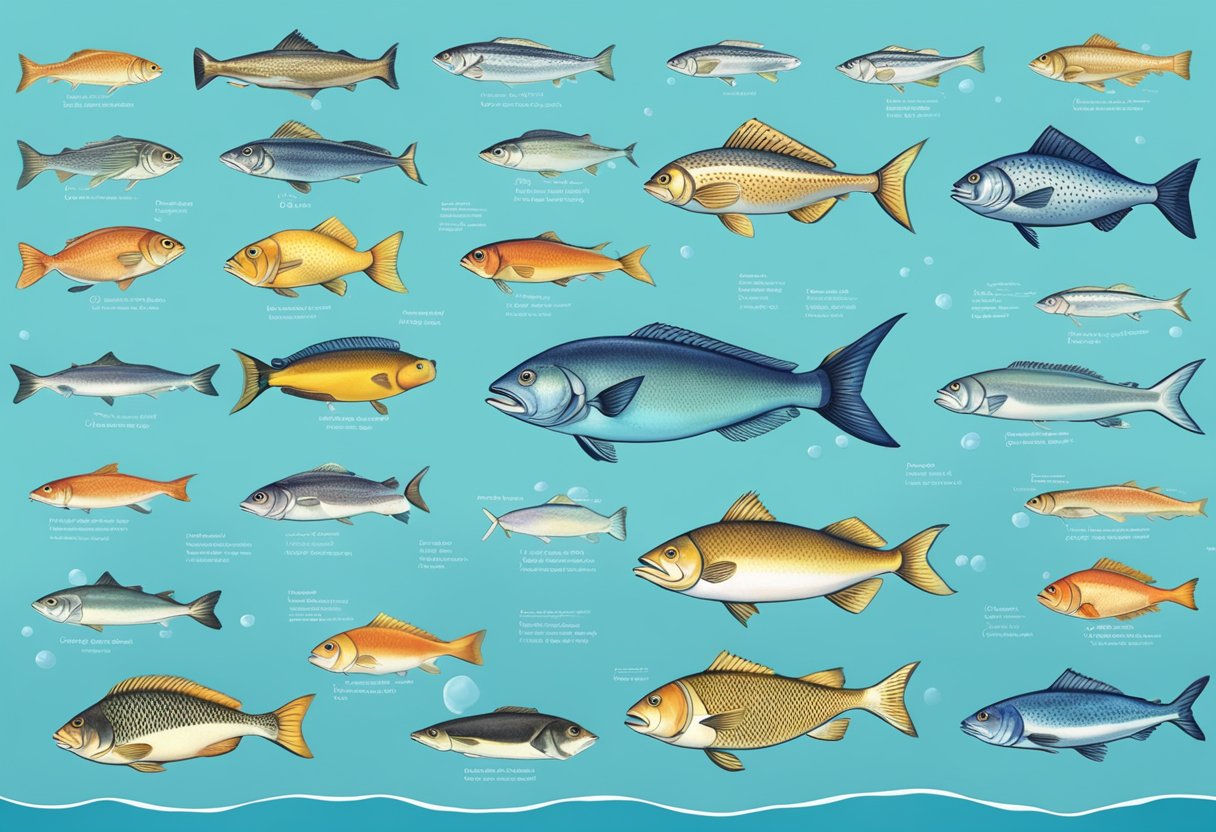Types Of Fish to Eat
Fish is a versatile and healthy food that can be prepared in a variety of ways. Whether you’re looking for a light and refreshing meal or a hearty and satisfying dish, there are many types of fish to choose from. Not only is fish a good source of protein, but it also contains essential nutrients like omega-3 fatty acids, which are important for heart health.
When it comes to selecting fish to eat, it’s important to consider both the nutritional benefits and any potential health risks. Some types of fish are higher in mercury than others, which can be harmful if consumed in large amounts. Additionally, certain types of fish may be more sustainable or environmentally friendly than others, so it’s important to weigh these factors when making your selection.
Overall, incorporating fish into your diet can be a healthy and tasty choice. By selecting the right types of fish and preparing them in a healthy way, you can reap the many nutritional benefits that seafood has to offer.
Key Takeaways
- Fish is a healthy and versatile food that can be prepared in a variety of ways.
- When selecting fish to eat, it’s important to consider both the nutritional benefits and any potential health risks.
- By choosing sustainable and healthy types of fish and preparing them in a healthy way, you can enjoy the many health benefits of seafood.
Nutritional Benefits of Fish

Fish is a highly nutritious food that is packed with essential nutrients such as protein, vitamins, and minerals. In addition, fish is known to be a rich source of heart-healthy omega-3 fatty acids, which are essential fats that our bodies cannot produce on their own.
Omega-3 Fatty Acids and Heart Health
Omega-3 fatty acids are known to have numerous health benefits, particularly when it comes to heart health. These essential fats have been shown to reduce the risk of heart disease, lower blood pressure, and improve overall cardiovascular health. Some of the best sources of omega-3 fatty acids include fatty fish such as salmon, mackerel, and herring.
Protein, Vitamins, and Minerals
Fish is also an excellent source of high-quality protein, which is essential for building and repairing tissues in the body. In addition, fish is packed with a variety of vitamins and minerals that are important for overall health and well-being. Some of the key nutrients found in fish include:
- Iron: Fish is a good source of iron, which is important for the production of red blood cells and the prevention of anemia.
- Vitamin D: Fatty fish such as salmon and tuna are rich in vitamin D, which is important for bone health and immune function.
- Calcium: Some types of fish such as sardines and salmon are also a good source of calcium, which is essential for strong bones and teeth.
- Zinc: Fish is a good source of zinc, which is important for immune function and wound healing.
- Selenium: Some types of fish such as tuna and halibut are rich in selenium, which is important for thyroid function and antioxidant protection.
Overall, fish is a highly nutritious food that provides a wide range of essential nutrients. Incorporating fish into your diet on a regular basis can help to improve your overall health and well-being.
Popular Types of Fish to Eat
When it comes to choosing the right type of fish to eat, there are a lot of options to consider. Some of the most popular types of fish to eat include salmon, whitefish varieties such as cod, haddock, and tilapia, and oily fish such as mackerel, sardines, and herring.
Salmon: Wild and Farmed Varieties
Salmon is one of the most popular types of fish to eat, and for good reason. It’s a great source of omega-3 fatty acids, which are essential for good health. There are two main types of salmon: wild and farmed. Wild salmon is generally considered to be the healthier option, as it contains more omega-3s and is less likely to contain harmful contaminants. However, farmed salmon is usually less expensive and more widely available.
Whitefish Varieties: Cod, Haddock, and Tilapia
Whitefish varieties such as cod, haddock, and tilapia are also popular choices for those looking to add more fish to their diet. These types of fish are generally low in fat and calories, making them a great option for those watching their weight. Cod and haddock are both mild-tasting fish that are often used in fish and chips, while tilapia has a slightly sweeter flavor and is often used in Asian and Latin American cuisine.
Oily Fish: Mackerel, Sardines, and Herring
Oily fish such as mackerel, sardines, and herring are rich in omega-3 fatty acids, making them a great choice for those looking to boost their intake of these essential nutrients. Mackerel has a strong, rich flavor and is often grilled or smoked, while sardines and herring are both small, oily fish that are often canned and used in salads or on top of crackers.
Overall, there are many different types of fish to choose from when it comes to adding more seafood to your diet. Whether you prefer mild-tasting whitefish or rich, oily varieties, there’s sure to be a type of fish that suits your tastes and nutritional needs.
Health Considerations and Risks
When it comes to consuming fish, it is important to consider the potential health risks. While fish is generally considered a healthy food choice due to its high protein content and omega-3 fatty acids, there are also some potential dangers to keep in mind.
Mercury Content and Fish Consumption
One of the primary concerns when it comes to eating fish is the potential for mercury contamination. Mercury is a toxic metal that can accumulate in fish and other seafood, and high levels of mercury can be harmful to human health.
Some types of fish are higher in mercury than others, so it is important to be mindful of your consumption. Pregnant women, nursing mothers, and young children are particularly vulnerable to the effects of mercury, so they should be especially careful about the types and amounts of fish they consume.
Sustainable and Eco-Friendly Choices
Another important consideration when it comes to choosing which fish to eat is sustainability. Overfishing and other unsustainable fishing practices can have a negative impact on the environment and the health of fish populations.
To make eco-friendly choices, consumers can consult resources such as the Seafood Watch program or the Aquaculture Stewardship Council (ASC) to learn more about sustainable and responsible seafood options. The Monterey Bay Aquarium also provides a helpful guide to choosing sustainable seafood options.
By being mindful of these health and environmental considerations, consumers can make informed choices about which types of fish to include in their diets.
Cooking and Preparing Fish
When it comes to cooking and preparing fish, there are a variety of techniques that can be used, depending on the texture of the fish and the desired outcome. Here are some tips and tricks to help you prepare delicious and healthy fish dishes.
Cooking Techniques for Different Textures
Different types of fish have different textures, which can affect the way they are cooked. For example, oily fish such as salmon and tuna are best grilled or baked, while white fish like cod and haddock are better poached or steamed. Here are some cooking techniques to consider:
-
Grilling: Grilling is a great way to cook fish with a firm texture, such as salmon or swordfish. Brush the fish with a little oil and season with salt and pepper before grilling for a delicious and healthy meal.
-
Baking: Baking is a good option for oily fish like salmon, as well as thicker cuts of fish like halibut or cod. Place the fish on a baking sheet and season with herbs and spices before baking in the oven.
-
Poaching: Poaching is a gentle cooking method that works well for delicate fish like sole or flounder. Simmer the fish in a flavorful liquid, such as white wine or fish stock, for a tender and flavorful meal.
Seasoning and Pairing with Herbs
When it comes to seasoning fish, less is often more. Simple herbs and spices like lemon, garlic, and dill can enhance the natural flavor of the fish without overpowering it. Here are some tips for seasoning and pairing fish with herbs:
-
Lemon: Lemon is a classic pairing with fish, adding a bright and tangy flavor that complements the delicate flavor of the fish. Squeeze fresh lemon juice over the fish before or after cooking, or add lemon zest to the seasoning mix.
-
Garlic: Garlic adds a savory flavor to fish dishes, and pairs well with herbs like thyme and rosemary. Try rubbing minced garlic onto the fish before cooking, or adding it to the seasoning mix.
-
Dill: Dill is a popular herb for fish dishes, adding a fresh and herbaceous flavor that pairs well with salmon and other oily fish. Sprinkle fresh dill over the fish before or after cooking, or add dried dill to the seasoning mix.
By using these techniques and seasonings, you can prepare a variety of healthy and delicious fish dishes that are sure to impress.
Selecting Fish at the Market
When it comes to buying fish, it’s important to know what to look for to ensure that you’re getting the best quality and freshest fish possible. Here are some tips for selecting fish at the market.
Freshness Indicators and Labels
One of the most important things to look for when buying fish is freshness. Fresh fish should have a mild ocean smell, bright eyes, shiny skin, and firm flesh. If the fish smells fishy or has a dull appearance, it’s likely not fresh.
Another way to determine the freshness of fish is to look at the sell-by date. However, it’s important to note that this date is just a guideline and doesn’t necessarily indicate the actual freshness of the fish.
Understanding Seafood Labels and Certifications
When shopping for fish, it’s important to understand the different labels and certifications that are used to indicate the sustainability and quality of the fish.
One label to look for is “wild-caught,” which means that the fish was caught in the wild rather than farmed. Wild-caught fish are generally considered to be of higher quality and more sustainable than farmed fish.
Another label to look for is the certification from the FDA, which ensures that the fish has been inspected and is safe to eat.
It’s also important to be aware of the different species of fish and their sustainability status. For example, sea bass and shark are both overfished and should be avoided, while shrimp is generally considered to be a more sustainable choice.
Overall, when selecting fish at the market, it’s important to consider factors such as freshness, sustainability, and quality to ensure that you’re getting the best possible product.






